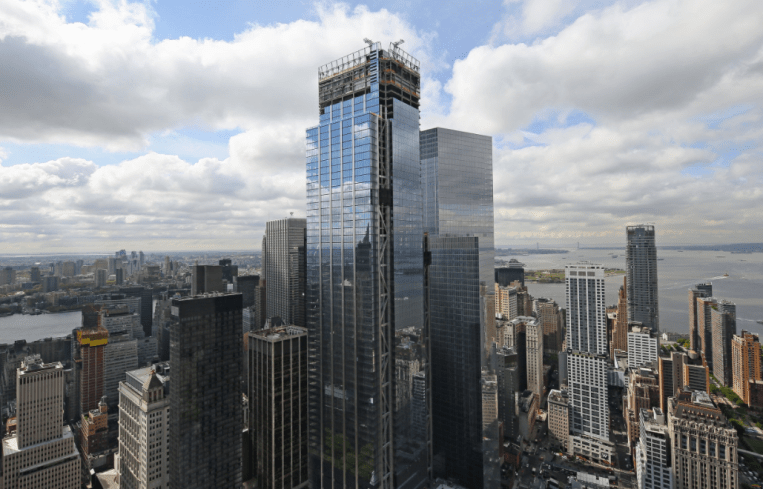Downtown Office Asking Rents Reach All-Time High: CBRE
By Rey Mashayekhi June 29, 2017 4:02 pm
reprints
Average asking rents of office space Downtown hit an all-time high of $62 per square foot in May, according to a new CBRE report which talked up Lower Manhattan’s continued, growing appeal to technology and media industry tenants.
The area’s office market has seen a “steady increase” in asking rents in recent years driven by an influx of new product, “dramatic improvements that have enhanced the neighborhood’s appeal” and the value proposition of space priced well below what tenants can find in the Midtown and Midtown South markets, per the report.
Developments like Silverstein Properties’ World Trade Center complex have facilitated that growth, with CBRE actively marketing 1.7 million square feet at the 80-story, 2.5-million-square-foot 3 World Trade Center where asking rents start in the low $80s per square foot. (Advertising media giant Group M anchors the property with roughly 700,000 square feet of space.)
While the southern-most point of the borough continues to appeal to tenants seeking space “priced well below” overall Manhattan average asking rents of $75 per square foot—with more than 1.2 million square feet of space currently available at below $50 per square foot and nearly 4.2 million square feet available at between $51 and $60 per square foot, CBRE indicates— the market is closing its price gap on Midtown and Midtown South.
Downtown asking rents are now only 23.5 percent below Midtown averages in the low $80s per square foot, compared with a 43 percent disparity in 2007 and a 36 percent differential in 2013, the report shows.
Downtown is also narrowing the gap with the vaunted Midtown South office market, which has seen tremendous growth over the past decade and where average asking rents have eclipsed $70 per square foot. In addition to shrinking the differential in asking rents between the two markets in the past four years to only 16 percent from 28 percent, Downtown has become an increasingly viable draw for the technology, advertising, media and information, or TAMI, tenants that have become synonymous with Midtown South in recent years.
Nearly 30 percent of all Downtown leasing activity this year has come from TAMI sector tenants, according to CBRE Executive Vice President Adam Foster, who discussed the report alongside other CBRE executives and Alliance for Downtown New York President Jessica Lappin at a media briefing this morning. Foster said “smaller to mid-sized” TAMI companies that are looking to expand their footprint have flocked to the market’s inventory of relatively affordable space.
Such tenants have been particularly drawn to the neighborhood’s sizable stock of pre-war office buildings—which have captured 52 percent of out-of-market relocations to Downtown since 2011, as tenants have “seiz[ed] the opportunity to secure architecturally distinctive space that would command substantial rent premiums in other parts of the city,” CBRE said.
Michael Rizzo, a senior vice president at CBRE, noted that Downtown’s heightened appeal for TAMI tenants has been fueled by the neighborhood’s growing population, which has tripled to 60,000 residents since 2000, as well as its increase in retail amenities and the “types of spaces” available to tenants.
Pre-built space, in particular, has become more popular with tenants and often accelerates leasing activity, Rizzo said, noting that pre-builts spanning 20,000 to 40,000 square feet are becoming increasingly prevalent in the market.
In addition to the burgeoning population base in Downtown itself, Lappin cited the neighborhood’s transit accessibility via a considerable array of subway lines (such as the 11 trains connected by the Fulton Center transit hub) and the city’s recently expanded ferry service, which currently serves the East River waterfront and South Brooklyn neighborhoods like Red Hook and Sunset Park, and will soon extend to Astoria, Queens. That accessibility has furthered Downtown’s appeal to companies seeking to accommodate a growing millennial workforce based heavily in Brooklyn and Queens, she said.
Lappin also pointed to the New York State Assembly’s vote this morning passing an omnibus bill that features a three-year extension on business tax incentives for Lower Manhattan commercial landlords. The incentives help “encourage investment in older [office] stock that we want to keep” while discouraging the trend of office-to-residential building conversions in the area.
As far as overall leasing activity, Downtown has had “a really good year” to date, according to Nicole LaRusso, CBRE’s director of research and analytics for the tri-state region. LaRusso pegged year-to-date leasing in the market at 2.8 million square feet, a number “trending ahead of the five-year average” and driven by a hike in “larger transactions”—such as TAMI tenant Spotify’s February deal for 378,000 square feet at 4 World Trade Center.


